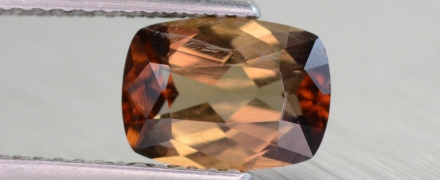open 10 am - 7 pm
laboratory is closed
Axinite

Continuing our acquaintance with gemstones, which are rarely found in the form of faceted inserts, let us turn our attention to the minerals of the axinite group - mangan- and ferroaxinite. Axinite is quite common in nature, but gem-quality cut stones are very rare. The most famous are stones from the deposits of alpine veins in France, Switzerland, represented by manganaxinite and ferroaxinite, and the Polar Urals (Puiva deposit), represented by manganaxinite. These minerals are characterized by dark violet (to purple) shades of low saturation. One of the distinctive properties of axinite is trichroism, as a result of which the facets made in a certain orientation of the crystal resemble alexandrite in appearance. Most often, axinite of low purity characteristics can be found in the form of cabochons or crystals of various degrees of transparency. Transparent crystals are very rare and are in demand both among collectors of minerals and manufacturers of collection cut.
В геммологической практике бывают весьма увлекательные случаи с диагностикой ювелирных вставок
Но помимо редкости цвета и высокой стоимости таких камней, многие розовые камни выделяются одной замечательной особенностью – они проявляют плеохроизм, то есть в зависимости от положения осмотра камня он может иметь дополнительные оттенки – оранжевый или пурпурный.
Currently, gemstones are produced by two fundamentally different technological methods - the High Pressure - High Temperature method (“HPHT”, High-pressure & High-temperature) and the Chemical Vapor Deposition (“CVD”, Chemical vapor deposition) method. The "HPHT" method is the most tested classical synthesis method, which can be used both carbon deposition on diamond from flux melts and catalytic reactions. In "CVD" synthesis, diamond growth occurs on a seed during carbon deposition mainly from a gaseous medium at relatively low temperatures and pressures.
Jewelry and precious stones are just such a category of goods, when buying which you need to pay attention to many criteria.
Sogdianite is a rather rare mineral and more often it can be found as a collection material (moreover, in systematic collections), and it is extremely rare in jewelry.






